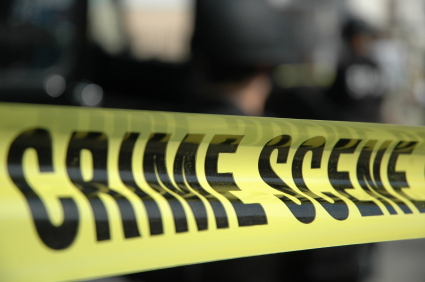Four years ago, my husband and I taught a series of classes for Kiss of Death, the mystery-suspense arm of the Romance Writers of America. We focused our workshop on private investigations, a field we know well after having being co-owners of a private investigations agency for years.
This post is part I of the class on crime scenes (with some information updated). A point we make throughout the class is that PIs mostly investigate crime scenes after law enforcement/others have finished their investigations and re-opened the crime scene back to everyday use.
You'd be surprised how much evidence can still be mined days or weeks later at a crime scene—for example, this last weekend we visited a former law enforcement crime scene and took photos of a strategically placed surveillance camera, not documented in the D.A.s discovery, that provided key evidence in a legal case. Years ago, we investigated a crime scene, 800-plus acres of ranch land, that the sheriff's office had investigated and returned to everyday use two months earlier. Our goal (as had been the sheriff's office) was to find 4 bullet slugs from a shooting, whose placement could prove a man's innocence. The next class discusses this case in more detail.
Let's kick things with the question...
Why Do Crime Scenes Matter?
In some crimes there are no witnesses and in the absence of self-incriminating statements by a suspect, the only means of obtaining a conviction may be through physical evidence (such as evidence with viable DNA, a blood sample or a fingerprint). In any crime, sharing knowledge of physical evidence with suspects may loosen tongues and stimulate confessions. DNA, fingerprints or serologic evidence are tough to debate and bring many criminals to a place where their lips move easily.
Note: A comment regarding an investigator sharing knowledge of physical evidence with a suspect. Interestingly enough, private investigators work under a burden created by ethical constraints that police detectives do not labor under. While courts have consistently held that police may lie to a suspect to stimulate a confession without tainting that confession (we once saw this in an episode of the TV series The Closer), very few private investigators can credibly present statements obtained by deceptive means. By “very few” we mean in the few instances where the PI has investigated an individual who’s extremely unsavory or has committed a particularly heinous act, jurors are more likely to trust that PI’s statements, even if the PI lied to obtain them. This is great fodder for a story.
In a crime scene, the area searched and the evidence sought will depend on the crime under investigation. In crimes of violence, the crime scene tells the detective what happened but the detective has to be able to read the signs left by the evidence (signatures of crime include fingerprints, blood stains, bullets, bullet holes, tool marks, fibers, hairs, glass fragments, fingernail scrapings, DNA samples, as well as items added, overturned, removed or displaced).









